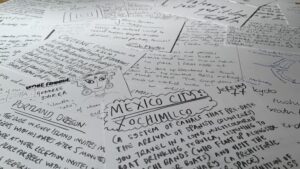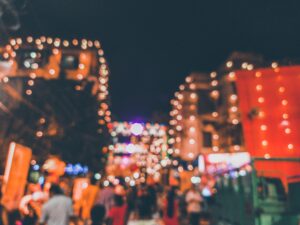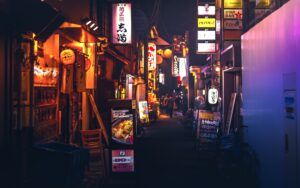52 Cities
The 52 Cities Project
3:40:11 14 December 2023
51° 05' 32.10" N 0° 02' 0.18" E
Last month FreeState held its 20th birthday at Lantana Shoreditch. As well as a little overview of what the night might hold, we asked everyone to bring a little something of their own. The invite:
‘One of the things we’re going to be looking at this coming year is the notion of ‘the experience city’. At the moment we’re gathering ideas – ideas that each week we’ll look at, comment on, write about, or be inspired by – that will help build a picture of the experience city. An example from Charlotte and Adam’s adventures this summer would be southern Italian city of Lecce and its Festa delle Luminarie, which sees the whole community exuberantly stepping out with parades and performers, banquets and dances, all set within a fairytale atmosphere of magical light installations bouncing off the polished white streets and squares. So, our question to you is this, can you help?! In other and more words, might you arrive on Thursday with thought of a city and the outstanding experience that characterises it? Could be very grand or rather humble, somewhat famous or totally niche. The key thing is, it means something to you! And what to do with that thought?’

As we more or less discussed on the night, it’s easy to forget how recent a phenomena the city is. Before the Mesopotamian city of Ur in 7,500 BC, most of the history of humanity would have been spent inhabiting – as clans and then tribes – anything from natural dwellings to something as substantial as the village and very occasionally a town. The last 10,000 years has seen an explosion in the number and size of cities. Today the world is home to thousands of cities, which house a staggering 54% of the planet, and which with each passing week become the home of another three million people, many of whom are escaping poverty, war, or lives bereft of opportunity. UN-Habitat estimates that in 2050 seven billion humans will be living in the city.
None of this ought to surprise. Site and model of efficiency, opportunity, and innovation, the city, as urbanist and writer Richard Sennett says, is so much more than its ‘ville’ or built form. It is also it’s ‘cité’ or life, the ‘lived’ that turns a city from a generic set of built form principles into a specific place teeming with the busy-ness of life. Which is not ignore all the negative effects of city life or the poverty of our imaginations when it comes to the design of some of our cities. Rather it is to acknowledge it as the most culturally ‘evolved’ of our inventions, a machine for competition and collaboration at enormous scale, a place that is the source of most of what might, for better or worse, be called ‘progress’.

All of which needs to weighed against and understood in the context of the central role the inexorable rise of the city has played in unsustainable population growth, levels of consumption, and energy use. The most cursory research will show that those countries that historically, presently, and increasingly have had the most urbanisation are also those that emit the most CO2. However, three mitigating points:
– One, where economic growth used to always positively correlate with a rise in emmissions, the rule no longer holds true of the likes of France, Germany, Sweden, Finland, Denmark, Italy, Romania, or even the US, all of which are successfully managing to decouple the former from the latter: that is, they’re growing and reducing emissions.
– Two, as well as being the source of ideas, governance and resources for the decoupling, the city is also a energy saver. The theoretical physicist Geoffery West proposes that the city is much like a biological system, wherein every time a system doubles in size, it’s metabolic rate rises by 75 percent rather than the expected 100 percent. As they scale up in size, cities are increasingly more efficient.*
– Three, this seemingly conterintuitive point about larger systems using proportionally less energy plays well to the conservationist Joe Walton’s assertion that the city and its capacity for sequestering much of humanity may well be the answer to reversing loss of biodiversity and the ecological systems critical to the planet’s health. Ecosystems largely bereft of human habitation will recover and grow.

So, back to our humble The 52 Cities Project, which with the help of the energy, ideas, and advice of those of you who attended FreeState’s birthday bash will see us spending 2024 shining a light – our torch a piece of writing, an interview, a little film, a podcast – on experiences that make the city what it is. Every week (perhaps beginning with artist Jeremy Hutchinson’s championing of Mexico City’s Xochimilco, or urban designers Rumi Bose and Ruchi Chakravarty’s choice of Calcutta’s Festival of Durga Puja, or business strategist Victoria Firth’s love for Beirut’s Bar Torino) a different city, a new experience. Roll on 1st January 2024.
For more on The 52 Cities Project, please contact either Adam Scott or Dave Waddell.
*Though West and colleagues are careful to distinguish the advantages of this particular economy of scale from the superlinearity of scales that are distinctly social, that in other words scale up at ever increasing speeds, an eventual collapse of the system continually averted by wealth and knowledge creation, which is in a kind of arms race with the activities and population growth it helps create.
Images courtesy of Roberto Carlos, Marak Piwnicki, and Ishita Sarka on Unsplash.



